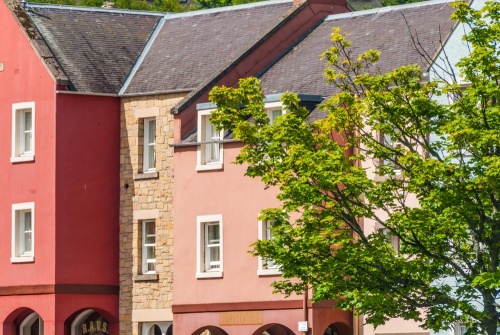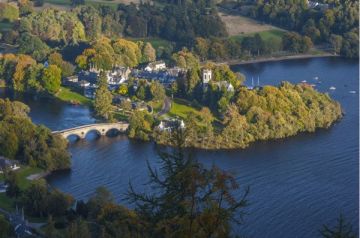
Jedburgh is a historic royal burgh in the Scottish Borders, 10 miles from the English border. The town's proximity to the border made it a gateway to Scotland, but also made it a target for raids during the centuries of wars between England and Scotland.
Jedburgh is a delight to visit, with its wonderful historic attractions and picturesque architecture. Enjoy beautifully restored and very colourful historic buildings around the market place and Canongate.
History
The town grew up on Jed Water, a tributary of the River Teviot. In the 9th century a minster church was established at Jedburgh ( 'mother' church for the region). Around AD 830 Bishop Ecgred of Lindisfarne established two settlements on the banks of Jed Water. Both were given the same name, 'Gedwearde', meaning literally 'settlement by the River Jed'.
Jedburgh Abbey
In 1138 King David I founded an Augustinian priory on the site of the earlier church. In 1147 the priory was raised to the status of an abbey. Over the course of the next few centuries Jedburgh Abbey grew to become one of the largest and most important monasteries in Scotland.
In 1214 Alexander II of Scotland granted Jedburgh the status of a royal burgh. That status helped ensure the town's prosperity throughout the medieval period as a trading and administrative centre.
In 1285 King Alexander III (1241-1286) came to Jedburgh to mary his second wife Yolande (daughter of the Duke of Dreux in France). The royal court almost certainly stayed at the castle.

Jedburgh was repeatedly attacked during border warfare between the Scots and English. We know that Edward I, the 'Hammer of Scots' came here at least once. The town and abbey were burned in 1523 and again in 1544. The abbey was finally suppressed in 1559.
Today, the abbey is preserved by Historic Environment Scotland. The best-preserved part of the medieval monastery is the abbey church, with the nave and transepts still standing to their full height.
A modern visitor centre displays objects found at the Abbey site including an 8th-century Anglian shrine, a Roman altar slab, and 9th-century cross heads.
Jedburgh Castle Jail
King David did not just concern himself with spiritual matters; not only did he found the abbey, but he established Jedburgh Castle on a riverside site at the southern end of the royal burgh. The castle became a royal residence, but it was captured by the English on so many occasions that it was seen as a military weak point.
The castle was finally destroyed in 1409 to avoid it falling into English hands again. In the 18th century the former medieval fortress became a prison, though it is still known as Jedburgh Castle.
Jedburgh gained a reputation for rough treatment of criminals, and 'Jeddart justice' became synonymous with hanging a man first and trying him later. In fairness, it seems that the moniker was a huge generalisation after one gang of ruffians was summarily executed.
In 1823 a new jail was built on the site of the medieval castle. This is the only surviving example in Scotland of a Howard Reform prison, a more humane system popularised by the prison reformer John Howard.

You can visit the 19th-century prison and see what life was like for prisoners in the 1820s. Part of the Castle is set aside as a museum tracing the history of Jedburgh, with displays ranging from archaeological finds to the official town drum and its collection of weights and measures.
The Jail is said to be haunted by the ghost of a man named Edwin McArthur, who was executed here in 1855.
Mary, Queen of Scots House
In 1566 Mary, Queen of Scots visited Jedburgh to preside over a circuit court. A fortified tower house was given to the Queen as a residence for the duration of her stay. During her stay at Jedburgh, Mary heard the news that her favourite, the Earl of Bothwell, had been seriously injured and lay wounded at Hermitage Castle, 20 miles to the south.
She impetuously embarked on a perilous ride to his side. Her return to Jedburgh was plagued by terrible weather and the queen contracted a serious illness. She arrived back at Jedburgh near death, and it was not certain she would survive. Survive she did, but in later years, when her reign was plagued with turmoil, she remarked, 'Would that I had died at Jedburgh'.
Today, the house where Mary stayed is preserved as the Mary, Queen of Scots Visitor Centre (sometimes known as Mary, Queen of Scots House). The house dates to the 16th century and stands on the edge of a public park with gardens and an original orchard.
Inside the house are exhibits on Mary's life, including a collection of her letters portraits, and needlework made by the queen in captivity, Look for the queen's death mask, a mould of her face taken after her execution at Fotheringhay Castle in Northamptonshire.
Just outside Jedburgh is Ferniehirst Castle, the family seat of Clan Kerr. Ferniehirst began as a fortified tower house, built in 1476 by Sir Thomas Kerr. Because of its location in the turbulent Borders, it became known as Scotland's Frontier Fortress and was captured and recaptured multiple times by both Scots and English.

Town Trail Highlights
One of the best ways to explore historic Jedburgh is to follow the Town Trail, linking important places in the history of the royal burgh. Each location is marked by a special plaque. The entire route is just 1.5 miles long and is a wonderful way to enjoy learning about Jedburgh and its rich history.
It will take about 2 hours to complete the trail, but please allow extra time if you are going to visit the abbey and Jail (and you really should do both). The walk begins and ends in Abbey Place.
One of the more modern sites on the Town Trail is the Public Hall, built in 1900 to replace the Corn Exchange which burned down a few years earlier. The Hall incorporates parts of a malt barn that once served as Jedburgh's armoury.
Across Abbey Place are The Ramparts, built in 1548 as gun emplacements by the French allies of the Scots defending Jedburgh from an English attack. The Ramparts now provide a lovely raised walkway.
In Abbey Place is the Carter's Rest, an inn that once served as the town's grammar school. At the top of Abbey Place is Newgate, a harled 18th-century gateway built to replace the earlier tolbooth. The gateway is topped by a spire rising 118 feet. Within the spire is a ring of three bells, one brought from the Abbey after it was suppressed.

Over the Newgate archway is a panel inscribed with the Burgh Arms and the motto, 'Strenue et Propere', or 'With vigour and success'. Under the arch are doors to windowless prisoner cells and on the next level up is a cell for condemned prisoners.
The market place once boasted a Mercat Cross, and the cross' location is marked by a plaque in the middle of the roadway. A second plaque set into the roadway shows where Kirkwynd Tower once stood. The tower stood beside the main approach to the abbey from the Market Place. It was built in 1551 or perhaps earlier and was torn down in 1791.
Also in the Market Place is the Jubilee Fountain, erected to honour Queen Victoria's Diamond Jubilee in 1899. Above the fountain rises a Gothic column topped by the figure of a unicorn holding the Burgh coat of arms.
Canongate was the original main entrance to the royal burgh. Look for the plaque to Robert Burns, marking the site of the house where the poet stayed in 1791 when he was made a Freeman of the Royal Burgh.
On Castlegate is the Sheriff Court, on the site of the Council House. The Court was built in 1812 by French prisoners of war. A courtroom was deed to the building in 1861.
Sir Walter Scott is known to have argued a case here in the previous courthouse in 1793 in his role as a defence lawyer. A plaque was erected on the side of the building to mark the centenary of Scott's death in 1932. Bonnie Prince Charlie came to Jedburgh in November 1745 and stayed at a house on Castlegate, now known as Prince Charlie's House.

On Abbey Close stood David's Tower, where the residence of Bishop David Panter stood in 1552. The tower was pulled down in the 17th century. Also in the Close is Wren's Nest, an 18th-century building erected by Lord Egerton on a site granted by King James VI to the Earl of Home in 1610. Look for a plaque between Numbers 6 and 7 commemorating the visit to Jedburgh of poet William Wordsworth and his sister Dorothy in 1803.
The Jedburgh 'Handba' Game
High Street is the setting for the annual game of 'Handba', played in early spring between the 'uppies' and the 'doonies' (areas of town). The traditional ball game is said to have its origins in the medieval period when locals killed the leader of a group of English raiders. They cut off his head and threw it in the air, prompting his followers to flee in alarm. Nothing so violent occurs today, and the 'Handba' event is eagerly anticipated each year in February or March.
Also on High Street is the Spread Eagle Hotel, built in the 18th century on the site of an inn visited by Mary, Queen of Scots in 1566. In the grounds of the Bank of Scotland building on High Street is the 'Loupin'-on Stane, used by riders to mount their horses.
Off High Street is Grefriar's Garden, a reminder that Jedburgh was once home to the largest Franciscan friary in Scotland. Jedburgh Friary (not to be confused with the Abbey) was founded in the 15th century by Sir Andrew Kerr of Ferniehirst and was the last monastic house to be established in Scotland.
Nothing remains above ground but the garden planting scheme shows the outline of foundation walls, drains and grave sites. The garden is planted to reflect the friars' interest in healing plants as well as plants used for practical purposes like dyeing cloth.
Canongate Bridge was once the main route into Jedburgh, but it is now a pedestrian-only footbridge. It dates to the 16th century and incorporates stones from Jedburgh Friary.
On the town side of the bridge is Piper's House, built in 1604 by Adam Ainslie. The house gets its name from Robin Hastie, the town's last official piper, who lived in part of the building. The Hastie family served as pipers for the royal burgh for three centuries.
Jedburgh is on the A68, 10 miles from the English border, seven miles east of Hawick and 10 miles south of Melrose.
About Jedburgh
Address: A68,
Jedburgh,
Borders,
Scotland
Attraction Type: Town
Location: On the A68, 10 miles south of Melrose and seven miles east of Hawick
Website: Jedburgh
Location map
OS: NT656202
Photo Credit: David Ross and Britain Express
POPULAR POSTS
NEARBY HISTORIC ATTRACTIONS
Heritage Rated from 1- 5 (low to exceptional) on historic interest
Jedburgh Abbey - 0.3 miles (Abbey) ![]()
Mary, Queen of Scots Visitor Centre - 0.4 miles (Museum) ![]()
Jedburgh Castle Jail and Museum - 0.6 miles (Museum) ![]()
Ferniehirst Castle - 1.4 miles (Historic House) ![]()
Waterloo Monument - 3.7 miles (Historic Building) ![]()
Mertoun House Gardens - 7.5 miles (Garden) ![]()
Dryburgh Abbey - 8.1 miles (Abbey) ![]()
William Wallace Statue - 8.7 miles (Historic Building) ![]()
Nearest Holiday Cottages to Jedburgh:
Jedburgh, Borders
Sleeps: 2
Stay from: £277.00 - 946.00
More self catering near Jedburgh



